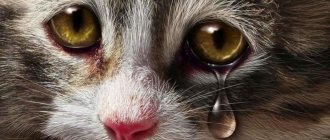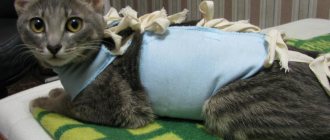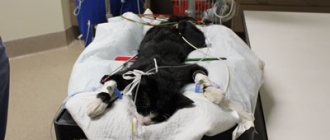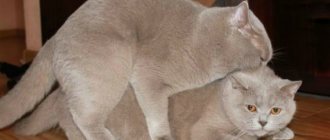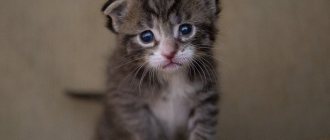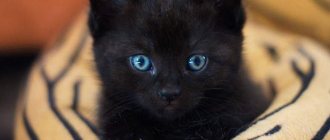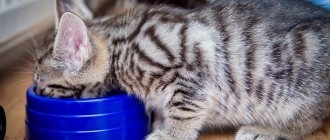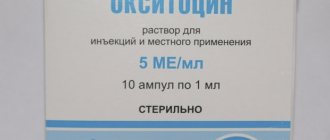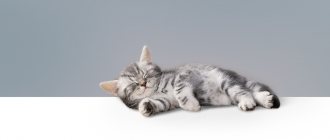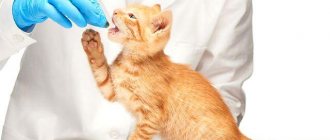Creating the right menu is not an easy task, and if your cat has recently given birth, you need to be even more careful when choosing products. 2-3 days after birth, the pet may have no appetite, but then it returns in double volume. Of course, during lactation the female loses a huge amount of proteins, fats, vitamins, minerals and carbohydrates, and this can only be replenished through food.
Food for a nursing cat should be: nutritious, balanced, fresh. It is better to give the animal food heated to 30-32 degrees. If earlier you fed your pet 1-2 times a day, now the number of feedings needs to be increased to 4-6 times. In the first week, the nutritional value of the diet should increase by 10%; under no circumstances should you overfeed.
Pregnancy and birth of a cat – what to expect?
If you are still thinking about the question of whether your cat needs to become a mother, read this section, perhaps it will change your vision. At sexual maturity, each animal begins to obey its instincts to look for a sexual partner. If everything goes well, mating occurs, after which the female bears the offspring for 2 months.
Throughout pregnancy, the cat’s body undergoes changes that affect literally all vital systems. The pet begins to produce more blood, since the body also provides embryos. Kittens develop quickly, which leads to increased consumption of proteins, carbohydrates and all nutrients.
While bearing offspring, the cat faces the discomfort that pregnant women often experience. The pet may suffer from vitamin deficiency, toxicosis and mineral deficiency. If the pregnancy proceeds successfully, the kittens are formed on time, after about 2 months the decisive moment comes - labor begins. At this stage, the cat faces the greatest danger - postpartum eclampsia. This condition is characterized by a sharp drop in all key blood parameters, including calcium and sugar.
In a state of postpartum eclampsia, a cat can quickly die or kill kittens.
Even if everything goes well, absolutely all cats suffer from dehydration and exhaustion after giving birth. The diet of a nursing cat should be maximally enhanced in accordance with the needs of the body. Regardless of age, breed or genetics, you can be sure that a nursing cat has calcium and mineral deficiencies. Constant milk production leads to greater consumption of water, proteins and vitamins.
The most difficult and critical time is the first three days after childbirth. During this period, the cat feeds the offspring with colostrum. The production of colostrum is necessary, since without it the microflora of kittens will be weak, and the babies themselves will not be able to digest milk.
A pregnant cat can be switched to an enhanced menu from the first week after mating. The problem is that owners of non-sterilized animals that have access to the street find out that their pet is pregnant by the fact that the belly “appears.” It is worth understanding that a noticeable rounding of the barrels occurs already in the second trimester. If you are faced with the fact that your pet is pregnant, it is recommended to switch the cat to a diet enriched with proteins and calcium. Be sure to give your cat a vitamin course and consult a veterinarian about your further actions.
Advice: if you do not want your cat to suffer from the hardships of bearing offspring, it is better to sterilize your pet before the onset of her first heat.
Statistics show that neutered, nulliparous cats live longer and have better health.
How much food should I give?
As much as she wants! Indeed, over the course of two months, a lactating female spends 3-4 times more energy than usual.
She feeds the babies often, which means the owner needs to provide the pet just as often and with plenty of healthy food, so that:
- her strength was restored after childbirth, and in the future she would be able to bear healthy and strong kittens;
- milk was produced in a timely manner;
- energy costs for feeding were replenished.
To do this, you need to increase the amount of high quality food! The calculation of the daily ration (on average, double!) is done experimentally and depends on the number of babies in the litter, the weight and age of the nurse.
At this time, the female’s tastes and appetite often change. The owners need to understand this situation and fulfill its reasonable and legal “whims”. For example, such
Proper feeding of a cat in the first days after birth
Immediately after giving birth, the cat may refuse to eat. If your pet does not eat well in the first few hours after giving birth, this condition can be considered normal. You need to be wary if your cat refuses water. Try offering your pet a warm drink, low-fat broth or fermented milk products. If you give water, it is advisable to add a little salt and sugar to it.
When preparing for the birth of a cat, it is better to buy a rehydron solution, which retains fluid in the body. It quickly and effectively helps in case of severe dehydration.
If after giving birth the cat refuses to drink and has a fever, consult a doctor immediately - these are the first signs of eclampsia.
The diet of a nursing cat provides for its special needs. It is not recommended to feed a young mother with simple food, especially with economy-class dry food. If your pet is accustomed to commercial food, it is better to consult a veterinarian for advice and selection of the optimal product. Many manufacturers produce special food for nursing cats, which enhances lactation and contains increased amounts of proteins and vitamins.
With a natural diet, in the first three days, it is recommended to give the cat only soft food. It is advisable to boil meat products, chop them and dilute them with broth. For the entire period while the cat feeds the kittens with colostrum, dairy products should be a priority.
To stimulate a cat's appetite, food needs to be heated.
By the third day, most cats can eat normally and are introduced to familiar foods. Changes should affect the frequency of feeding. In the last stages of pregnancy, the cat is physically unable to eat enough food at one time and must be switched to fractional feeding. Immediately after giving birth, it is also recommended to feed the cat in small portions, but often, 3-5 times a day.
Attention - mastitis!
The most common disease in a lactating cat - inflammation of the breast - occurs from infection of the wound on it, also due to stagnation of milk, if it is in excess, because there are few kittens or even... just one.
Prevention: maintaining maternal hygiene and cleanliness of the bed, good nutrition and frequent inspection by the owner. In case of pain, redness, lumps, or increased temperature in the breast area - an urgent visit to the doctor!
How to prevent exhaustion in a nursing cat
After giving birth, you may notice that your cat has lost a lot of weight. This process is inevitable, since the body gradually adapts to the costs of milk production. If the cat's diet is not strengthened at this point, the condition will develop into exhaustion. There are several methods to prevent exhaustion in a nursing cat, but each of them must be adapted to the individual situation.
One common cause of malnutrition in nursing cats is multiple litters. In nature, cats give birth to 2–3 kittens; a pet can give birth to 5–8 babies or even more. If your cat has given birth to more than six kittens, you need to think in advance about how to feed them.
Typically, the last kitten or pair of kittens in a multiple litter is slightly stunted. This is explained by the fact that stronger kittens push babies away from their mother's nipples. You have two options: feed the kittens or make sure that each of them eats well. The only method of monitoring the development of kittens is regular weighing. Timely introduction of supplementary feeding will not only help to avoid growth retardation in kittens, but will also protect the cat from exhaustion.
To supplement kittens, you can use goat's milk, special infant formula without sugar and additives, or powdered cat's milk substitute. Until recently, kittens were often supplemented with cow's milk diluted with water. Today this method is considered incorrect, since cow's milk often leads to dysbiosis and death of kittens.
Goat's milk is considered too fatty, but if there are no alternatives, it can be diluted in half with boiled water and used to supplement feeding of babies. Cats should also be given milk unless they are lactose intolerant. If a cat has milk sugar intolerance, whole milk is replaced with fermented milk products.
Infant formulas designed for infant feeding do not exactly meet the needs of kittens, but are a better alternative than goat's or cow's milk. When purchasing a formula, make sure that it is intended for children from birth, does not contain sugar or its substitute, and does not contain additives (berries, cereals, etc.). As a temporary supplement to the diet, infant formula can also be offered to a nursing cat. The undoubted advantage of infant formula is that they contain sufficient amounts of proteins and carbohydrates.
When introducing supplementary feeding, make sure that the kittens do not gain excess weight. Obesity before the age of 1 month is fraught with abnormal development and even death of babies.
The best choice for supplementing kittens is powdered cat milk replacer . The products are manufactured specifically for kittens aged from birth to 1 month. Naturally, almost all components of the milk formula are synthesized, that is, they are not natural.
When supplementing kittens with a cat's milk substitute, there is a risk of developing allergies, which are difficult to detect. The first symptoms are lacrimation, itching and other external manifestations. In blind kittens, this symptomatology is very difficult to detect, so when supplementary feeding is introduced, it is recommended to examine the babies daily for redness on the skin.
Let's figure out what foods are best to feed a nursing cat. Most owners become interested in this topic when they notice that their babies do not have enough milk. Unfortunately, there are no universal feeding schemes to produce more milk. Milk is a derivative of a wide range of nutrients, vitamins and minerals. To enhance lactation, use grated walnuts, a decoction of wild raspberry leaves, nettle inflorescence, and even an infusion of egg shells.
When using any drug that enhances lactation, you need to understand the risks. The cat's body will produce more milk, but it is not a fact that it will be as nutritious, that you will not harm the cat's health, that the kittens will not begin to lag behind in development.
The diet of a nursing cat should be dominated by dairy and meat products . For the first 7–10 days after birth, you need to choose foods for feeding your pet that are easy to digest and as absorbable as possible. During this period, the smooth muscles in the abdominal cavity will have time to recover, which will relieve the cat from discomfort during bowel movements.
Another common cause of exhaustion in lactating cats is nursing their offspring for too long. At the age of 1 month, kittens should begin to be offered boiled minced meat, dairy products or special food for kittens if you plan to raise the babies on a commercial diet.
At the age of one and a half months, kittens' milk consumption should decrease significantly as their interest in “adult” food increases. Please note that if you do not offer supplementary feeding to the kittens, they will continue to suckle from their mother as their food needs only increase.
What to do if the moment of weaning from the mother has been missed and adult kittens continue to suck milk? In this case, it is not recommended to act roughly: separate the mother and kittens, smear the cat’s nipples with bitter solutions, etc. The best option is to provide the cat with a separate shelter that is inaccessible to kittens. The cat will be able to independently decide when to hide from the kids. Kittens will have no choice but to be interested in the food that is in the bowl.
Typically, the process of weaning kittens from cat suckling takes only 2-3 days. Kittens that have reached one and a half months of age need to expand their taste range, so they willingly consume new foods that are offered to them.
"Special Tartans"
The diet for newborn kittens depends on age, weight, temperament, and individual characteristics. For example, kittens and nursing mothers of the Scottish breed need food with a high calcium content. After all, the mutating lop-eared gene has endowed Scottish cats not only with beautifully curved ears, but also with an increased risk of developing pathologies of the musculoskeletal system.
Therefore, the Scottish Fold begins to be fed with adjusted food from the first trimester throughout pregnancy. Calcium serves as the main building material for bone formation, and in its pure form it is not absorbed by the cat’s body. Therefore, in complex foods it is supplemented with magnesium, potassium, phosphorus, useful additives, and microelements.
Nutrition of the lop-eared mother
The right food for a future Scottish mother, in addition to a complex of minerals, should contain a sufficient amount of protein, taurine, rough fiber and fatty acids (Omega3, Omega6). In order to have milk, it is recommended to introduce weak meat broths, milk or fermented milk products into the diet and provide free access to fresh water.
So what exactly can you feed after childbirth? After all, it is so important to provide for such nuances as:
- so that there is milk;
- proper nutrition;
- satiety of mother and cubs;
- normal functioning of the gastrointestinal tract.
Baby food
In order for the postpartum mother to regain her strength and for the babies to develop normally, from the age of 3 weeks the fluffy babies begin to be fed with milk.
When there are more than six children in a litter, formula for newborn kittens is given from the age of five days. At one month, the cubs independently try to eat soft food in the form of mousse (pate).
Important
: Little Scottish cats will not have difficulties with digestion and stool if the nursing “Scottish” after giving birth eats the same “baby” food.
And may the loving kitty mom always be well-fed, and may her furry babies be healthy.
Until next time.
Pedigree feed lines
If you have a purebred pet, it is better to choose food based on its characteristics. There are a huge number of brands that produce specialized food for a specific breed. Specialists take these breeds into account in advance and prepare the right diet for your pet.
During the lactation period, you should not skimp on your pet’s nutrition, because if you pay due attention to this point, you will save yourself from a number of problems. Experienced breeders prefer several types: Hills, Royal Canin Queen or Royal Canin.
These are the most optimal and high-quality brands that really produce good food. In the price category they are higher than Whiskas, Oscar and so on. But the quality and composition speaks for itself.
Why you should choose these brands:
The rulers are specially developed taking into account the characteristics of the pet’s breed and life period.
All components that the food contains primarily have an anti-inflammatory effect. They improve intestinal microflora and restore immunity after pregnancy.
The food consists of 1/3 protein and contains all the necessary vitamins and minerals. They do not add impurities that cause the cat to go crazy and start overeating. Has no pungent odor or dye.
Picture: What can and cannot be given to a cat during pregnancy
